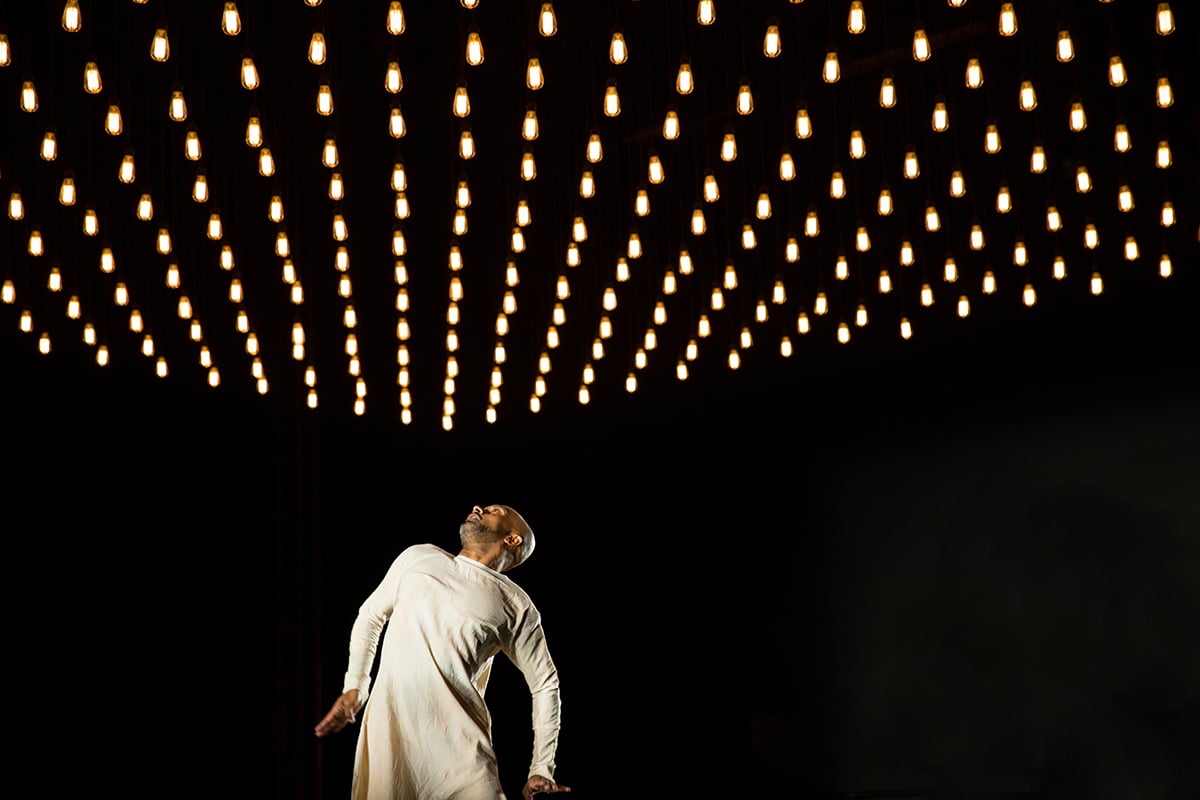Spread across four major London venues over four months, the twelfth edition of the Darbar Festival marked the first time that dance was accorded a prominent place in the programming. Given that the dance curator was Akram Khan, a long-time associate artist of Sadler’s Wells, it made sense for the man himself to kick off four days of Sadler’s-set events encompassing performances, master-classes and talks scheduled during mornings, afternoons and nights.
Khan has an abiding interest in bringing mythological sources and elements into his work, including those slanted towards more contemporary concerns or forms of expression. XENOS, which he claims will be his last contemporary full-length solo, fits that bill. The piece is based on research into the story of Prometheus (a name associated with the notion of ‘forethought’), the Greek Titan who fashioned humankind out of clay and earth and, flouting Zeus’ wishes, stole fire to give to his creations. For this act Prometheus was duly punished by being chained to a mountain where an eagle would come to eat his liver for eternity.
At the festival Khan unveiled a twenty-minute and more classically-inclined precursor of the solo. Economically entitled X, it began with an ominous voice-over – ‘Do not think this is war. This is not war. It is the ending of the world’ – and a glorious effect as Khan, centre-stage in white and wearing ankle bells, struck a match that seemed to ignite the field of small amber light bulbs (21 x 21, or 441 of them) suspended just above his head. Designed by Aideen Malone, the lights rose higher as Khan plunged into motion fuelled by musicians on either side: Aditya Prakash, sharing vocal duties with percussionist B.C. Manjunath stage left, both seated on a platform, and, opposite them, bass player (and vocalist) Nina Harries, saxophonist Tamar Osborn and Andrew Maddick on violin, all standing. The evocative score was by Vincenzo Lamagna, Khan’s collaborator on his 2016 reinvention of Giselle for the English National Ballet.
With its scraping, monstrously guttural yet vocally filigreed sound, Lamagna’s music lent strong support to Khan’s whirlwind spins and pronounced sense of attack. This was, presumably, a Prometheus on the offensive, with Khan firing on all cylinders and seeming to draw down invisible flame with his flared hands and stamping feet. But you might also, at a stretch, deem Khan to have been the embodiment of humanity itself. Such ambiguity was built in to this teaser for a work that won’t première in a finished form until 2018. The bottom line was that Khan was in sleek, powerfully fine fettle. He also conveyed vulnerability by lying on his side and shifting his limbs to breathy, crackling aural accompaniment, thereby eliciting light laughter from some audience members enjoying the discomfiting simulation of snapping bones and joints. He picked himself up when the music slowed, soothed by spirit-healing vocals and playfully yet calmly walking his fingers on his arm until, eventually, Malone’s brilliant hanging lights descended.
X was, in essence, an inconclusive albeit promising taste of things to come. What ensued, after a bit of talk from Khan and a few short, self-congratulatory speeches by festival organisers, was a jam session structured as a call-and-response between dancer and musicians. Here, again, Khan was on form, unleashing a volley of rhythmic footwork possibly matched but not surpassed by his colleagues.
The remainder of the (long) evening was both demanding and rewarding. On Khan’s heels came more than an hour of tala (rhythm) on Carnatic instruments, from Patri Satish Kumar on mridangam, Triplicane Sekar on tavil (a barrel-shaped drum) and Amrit Khanjira (khanjira, a frame drum of the tambourine family); and, after the interval, raga provided by Pravin Godhkindi’s bansuri (flute), accompanied by tabla-player Supreet Deshpande. The tala trio are clearly masters, transmitting via their respective instruments a variety of textures and tones from fluttering to jangling to thunderous with a relaxed yet alert bonhomie. This was still something of an endurance test likely to be most appreciated by hard-core percussion fans. I couldn’t stay the distance, choosing instead to view an exhibition of Manuela Benini’s arresting ‘Red Dress Project’ imagery in the foyer areas as Godhkindi’s lovely, melodious notes floated out from the auditorium.
